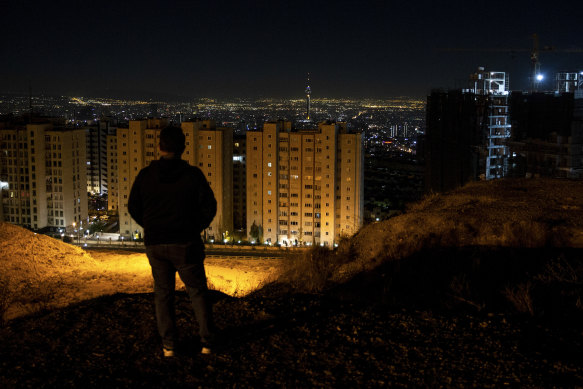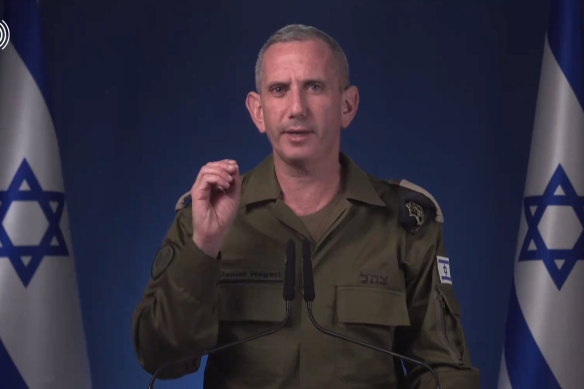
Initially, nuclear facilities and oil installations had been seen as possible targets for Israel’s response to Iran’s October 1 attack, but in mid-October the Biden administration believed it had won assurances from Israel that it would not hit such targets, which would be a more severe escalation.
Reuters reported a senior Biden administration official as saying Saturday’s strikes appeared to have been a targeted and proportional response to Tehran’s earlier attacks, and this should be the end of direct exchange of fire between the two countries.

There were no immediate reports of damage or casualties.Credit: NYT
Explosions heard across Tehran
Iran’s state-run media acknowledged blasts that could be heard in Tehran and said some of the sounds came from air defence systems around the city. But beyond a brief reference, state television for hours offered no other details.
A Tehran resident told The Associated Press that at least seven explosions could be heard in the first wave of attacks, which rattled the surrounding area.
As explosions sounded, people in Tehran could see what appeared to be tracer fire light up the sky. Other footage showed what appeared to be surface-to-air missiles being launched.
Iran closed the country’s airspace early on Saturday, and flight-tracking data showed commercial airlines had broadly left the skies over Iran, and across Iraq, Syria and Lebanon.
The White House said US President Joe Biden had been briefed and would continue to receive updates.
In Syria, the state news agency SANA, citing an unnamed military official, reported missile fire targeting military sites in the country’s central and southern regions. It said Syria’s air defences had shot down some of the missiles. There was no immediate information on casualties.
Missile attacks by Iran led to Israeli assault
Loading
Iran fired a wave of missiles and drones at Israel in April after two Iranian generals were killed in an apparent Israeli airstrike in Syria on an Iranian diplomatic post. The missiles and drones caused minimum damage, and Israel – under pressure from Western countries to show restraint – responded with a limited strike that it didn’t openly claim.
But after Iran’s early October launch of at least 180 missiles into Israel, Israel promised a tougher response, with Prime Minister Benjamin Netanyahu saying Iran had “made a big mistake”. Iran said the barrage, which caused only minimal damage and a few injuries, was retaliation for recent attacks that killed leaders of Hezbollah, Hamas and the Iranian military.
A forceful Israeli strike on Iran risks further entangling the US, which maintains a large troop presence in the Persian Gulf and has helped Israel defend itself against attacks by Iran and its proxies.
Before Iran’s October attack, Israel had landed devastating blows against Hezbollah, which has been firing rockets into Israel near-daily for over a year – ever since the deadly Hamas attack against Israel that sparked the war in Gaza.

“Like every other sovereign country in the world, the State of Israel has the right and the duty to respond,” Israeli military spokesman Rear Admiral Daniel Hagari said.Credit: Screenshot
Dozens were killed and thousands wounded in September when pagers and walkie-talkies used by Hezbollah exploded in two days of attacks attributed to Israel. A massive Israel airstrike the following week outside Beirut killed Hezbollah’s longtime leader, Hassan Nasrallah, and several of his top commanders.
Israel then ratcheted up the pressure on Hezbollah by launching a ground invasion into southern Lebanon. More than a million Lebanese people have been displaced, and the death toll has risen sharply as airstrikes continue to hit in and around Beirut.
Israel has said it will continue to strike Hezbollah until it is safe for Israeli citizens displaced from their homes near the Lebanon border to return. Hezbollah has vowed to keep firing rockets into Israel until there is a ceasefire in Gaza.
Israeli strike is the latest in the Middle East wars
When Hamas and other militants attacked Israel on October 7, 2023, they killed 1200 people and took some 250 hostages into Gaza. In response, Israel launched an air and ground offensive against Hamas, and Netanyahu has vowed to keep it up until all the hostages are freed. Some 100 remain and roughly a third are believed to be dead.
More than 42,000 Palestinians have been killed in Gaza, local health officials said.
Israel’s strikes on Iran on Saturday happened as US Secretary of State Antony Blinken was arriving back in America after a tour of the Middle East where he and other US officials had warned Israel to respond in a way that would not further escalate conflict in the region.
Loading
Two US officials speaking on condition of anonymity said the US was notified by Israel in advance of the strikes but there was no US involvement in the operation.
Israel and Iran have been bitter foes since the 1979 Islamic Revolution. Israel considers Iran its greatest threat, citing its leaders’ calls for Israel’s destruction, their support for anti-Israel militant groups and the country’s nuclear program.
Israel and Iran have been locked in a years-long shadow war. A suspected Israeli assassination campaign has killed top Iranian nuclear scientists. Iranian nuclear installations have been hacked or sabotaged in mysterious attacks blamed on Israel.
Meanwhile, Iran has been blamed for attacks on shipping in the Middle East in recent years, which later grew into the attacks by Yemen’s Houthi rebels on shipping through the Red Sea corridor.
Meanwhile on Friday, Israeli strikes on residential areas in southern Gaza killed 38 people, including 13 children from the same extended family, Palestinian health officials said, while in northern Gaza, Israeli forces had raided Kamal Adwan Hospital. In Lebanon, Israeli strikes killed three journalists working for news outlets considered to be aligned with Hezbollah.
AP
Get a note directly from our foreign correspondents on what’s making headlines around the world. Sign up for our weekly What in the World newsletter.



























